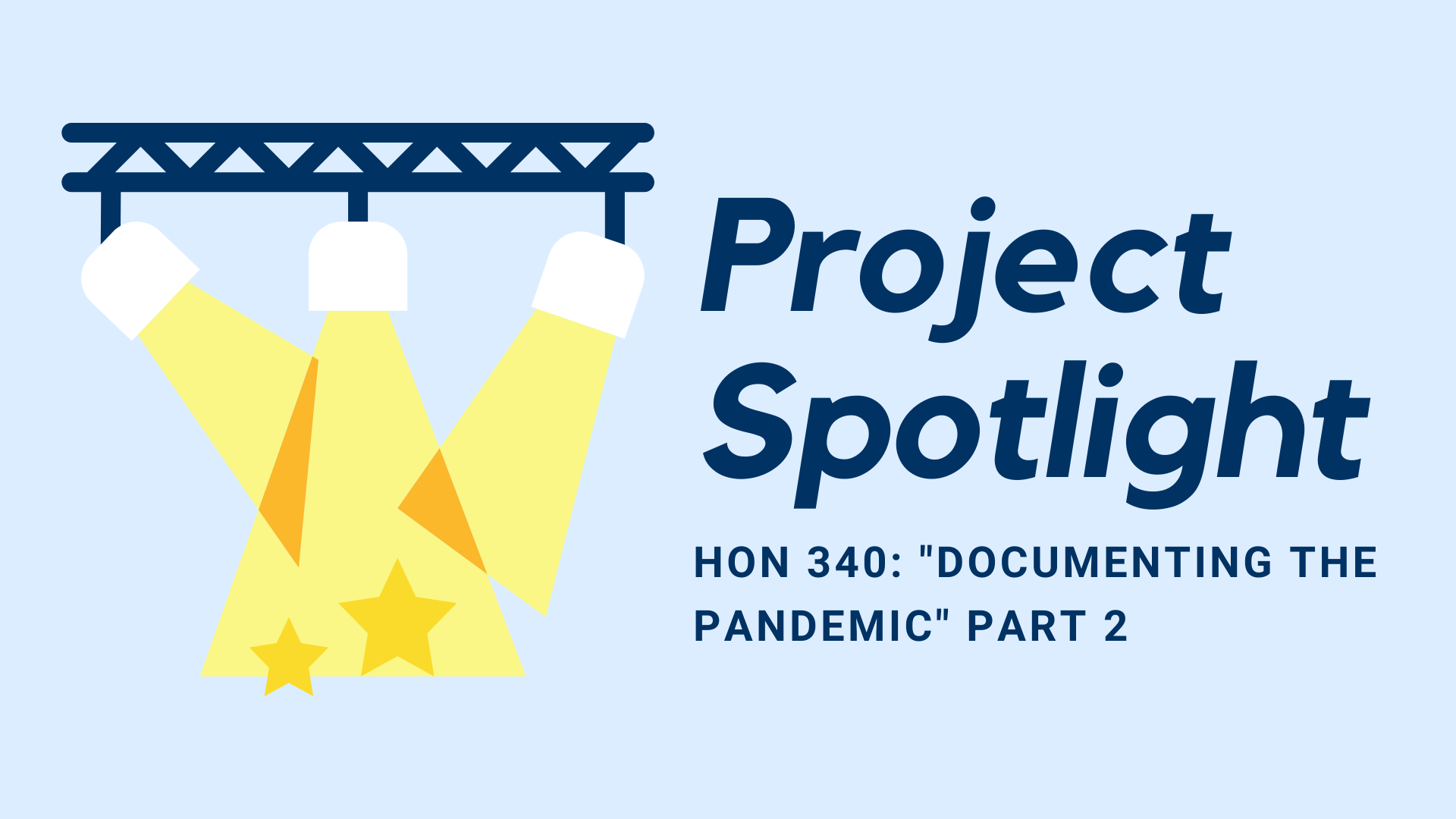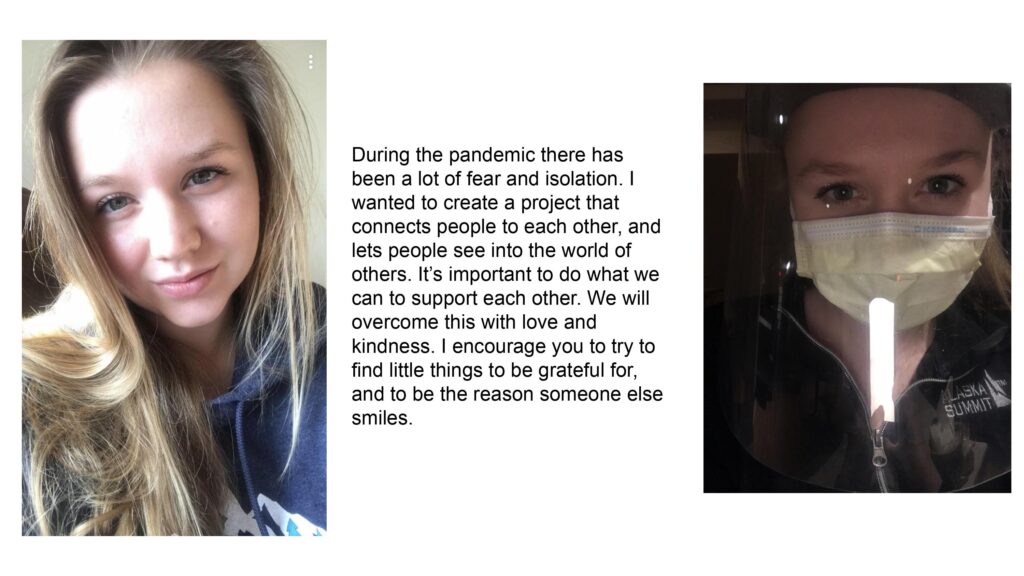
Project Spotlight: A Deep Dive into “Documenting the Pandemic,” Part Two
Project Spotlight is a monthly series dedicated to sharing outstanding Honors projects, both in and out of the classroom. This month, we will dive into the Winter 2020 Honors Tutorial HON 340 “Documenting the Pandemic,” taught by Professor Katie Quirk. This interview with HON 340 student Emily Kontio is part two of a two-part series. Click here to read part one, an interview with Professor Katie Quirk.

HC: Describe your art piece/project.
EK: My project is a collection of photographs. I collected two pictures from all of my participants: one with them wearing a mask and one without a mask. I also collected a quote from them, some people provided me with an overview of their experience with the pandemic, and shared something that they thought people should know right here. These pictures are going to be glued onto a piece of colored paper, one on each side of the paper. Then the quote will be under the masked picture, and where they are from will be under the unmasked picture. I am going to laminate these, and hang them in a tree on campus, so that it has a windchime effect.
HC: What was the primary inspiration behind your piece? How did you begin to formulate your idea?
EK: During the class we discussed a lot of our experiences with the pandemic, and we had all experienced something different. I thought that everyone’s unique experiences were really interesting, and I also knew family and friends who had different experiences. I decided to share these experiences, because I think that understanding what other people have gone through is the first step to empathy and compassion.
The idea of the masked and unmasked pictures came from a conversation I had with Professor Quirk. I mentioned that I started working at my job during the pandemic, so I have gotten to know my coworkers all with masks. Then when I see them eating (socially distanced), or I get a Facebook request from one of them, I often find myself so surprised to see their face. Professor Quirk and I talked about making little cards with masked and unmasked pictures, or a collage of these pictures, and over time it developed to my current project.

HC: Discuss your chosen medium. What drew you to that medium for this project? Was it something that you had experience working with before, or was this a completely new endeavor for you?
EK: I chose to use pictures, because I liked that you could really see people and get a feel for them. There’s a picture of my grandpa in my project which I absolutely love, it really shows his personality. You also see how different masks make people look, and how much of their face you can’t see. I grew up making scrapbooks with my grandma, so I’m used to working with photos. I have never laminated anything before, so we will see how that goes.
HC: Describe your creative process. What was it like working on this project?
EK: My idea for this project developed over the first couple of weeks, and there were many other ideas that I had but didn’t end up using. One of the things we did in this class was to look at art and media about the pandemic, we listened to podcasts, viewed art, and read short stories.
The first week we analyzed the styles and techniques the authors used, and the second week we tried creating our own. Inspiration would come from little things, a quote from a podcast, a discussion in class, or a picture. I really enjoyed working on the project. I am someone who does not claim to be creative, and usually hates creative projects. But there were so many different ways we could go with this project, and Professor Quirk really encouraged us to think outside the box, and to create a project that could be shared with the public.
HC: What was the HON 340 class environment like? Did your peers influence your idea, creative process, or the outcome of your project?
EK: I was a little worried after I signed up for this class that it would be all doom and gloom. I was one of the people who found myself avoiding the news and oftentimes social media during the pandemic, and I was worried that this would be what we were talking about. I was pleasantly surprised by the class. We had a lot of really great conversations, it was a place for us to share our experiences as well as hear others. We also discussed how art could be really cathartic, and I found this to be true.
When we brainstormed project ideas we made a big list as a class, and then Professor Quirk had us go into more detail about some of them. The last week of the class we spent workshopping. We each presented our project to our group, and we received positive and negative feedback on our work, these conversations were run by our peers, and if it was your project you didn’t talk until the end. These workshops were really helpful, it let you know what worked for people about your project and what didn’t. There was also some collaboration within our class. Two of my classmates created a final project together, and I know others helped with the collection of photographs and other things for projects.
HC: Did working on this project change how you view the pandemic and its impact?
EK: Working on this project has really shown me just how differently people have been affected by the pandemic. Some people haven’t experienced a whole lot of change, they continue with their daily life, but with a mask. Other people are doing really well, some are making more money, a lot of people are spending more time with their family. Then there are those people who are really struggling, some with their mental health, others financially, and others are grieving the loss of loved ones. I would say that overall it’s important to consider how the pandemic has affected everyone, and consider reaching out and doing what you can to help. Even if that’s just a text or a phone call.

HC: What are hoping that viewers take away or think about after seeing your work? What conversations do you hope your work sparks?
EK: Really I just want people to hear some other perspectives of the pandemic. and to see that we are all in it together. I know that’s a cheesy saying, but after hearing stories from all over the US and the world that is the one thing I have found to be true. I also think it’s important to highlight that although the pandemic has significantly changed our lives, and we have lost so many people, good can still be found. I never would have taken this class had it not been for the pandemic. I hope that it sparks more understanding and kindness.
